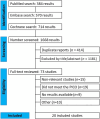The Health-Related Quality of Life for Cemented Versus Uncemented Hemiarthroplasty in Elderly Patients With Femoral Neck Fractures: A Systematic Review and Meta-Analysis of Randomized Controlled Trials
- PMID: 39726286
- PMCID: PMC11787973
- DOI: 10.1111/os.14339
The Health-Related Quality of Life for Cemented Versus Uncemented Hemiarthroplasty in Elderly Patients With Femoral Neck Fractures: A Systematic Review and Meta-Analysis of Randomized Controlled Trials
Abstract
Objective: Femoral neck fractures in the elderly are a global health issue, with the choice between cemented and uncemented hemiarthroplasty remaining a topic of debate. This systematic review and meta-analysis aims to compare the effects of the two surgical options on health-related quality of life (HRQoL), mortality, and functional outcomes.
Methods: We searched PubMed, Embase, and Cochrane databases for randomized controlled trials (RCTs) comparing cemented with uncemented hemiarthroplasty in patients aged 50 years and older with femoral neck fractures. The primary outcome of interest was HRQoL as measured by the European Quality of Life 5-Dimension Questionnaire (EQ-5D) score. Secondary outcomes included mortality, surgical, general, and local complications.
Results: We included 20 RCTs with a total of 3680 patients with femoral neck fractures, of whom 1871 (50.5%) underwent cemented and 1809 (49.5%) uncemented hemiarthroplasty. The follow-up ranged from 1 to 6 years. The early (after 3-4 months) EQ-5D utility score (MD 0.07; 95% CI 0.03-0.12; p = 0.003; I 2 = 22%) and the 12-month EQ-5D utility score (MD 0.08; 95% CI 0.00-0.16; p = 0.04; I 2 = 67%) suggested an improved HRQoL in the cemented hemiarthroplasty group. The outcomes of 1-year mortality, requirement for additional surgeries, surgery duration, risk of pulmonary embolism, pressure sores or ulcers, intraoperative fractures, and periprosthetic or postoperative fractures demonstrated significant differences between the two groups.
Conclusions: The use of cemented hemiarthroplasty in patients with femoral neck fractures presented better results when compared to uncemented hemiarthroplasty in terms of HRQoL during the first year after surgery and greater mortality reduction at 1 year follow-up and reduced the need for further surgery. Therefore, the use of cemented hemiarthroplasty may be preferred for the treatment of femoral neck fractures in elderly patients.
Keywords: cemented; health‐related quality of life; hemiarthroplasty; hip fractures; uncemented.
© 2024 The Author(s). Orthopaedic Surgery published by Tianjin Hospital and John Wiley & Sons Australia, Ltd.
Conflict of interest statement
The authors declare no conflicts of interest.
Figures




Similar articles
-
Surgical approaches for inserting hemiarthroplasty of the hip in people with hip fractures.Cochrane Database Syst Rev. 2025 Jun 13;6(6):CD016031. doi: 10.1002/14651858.CD016031. Cochrane Database Syst Rev. 2025. PMID: 40511667 Review.
-
The Comparison between Cemented and Uncemented Hemiarthroplasty in Patients with Femoral Neck Fractures: A Systematic Review and Meta-analysis of Randomized Controlled Trials.Orthop Surg. 2023 Jul;15(7):1719-1729. doi: 10.1111/os.13716. Epub 2023 May 8. Orthop Surg. 2023. PMID: 37154088 Free PMC article.
-
Are There Differences in Performance Among Femoral Stem Brands Utilized in Cementless Hemiarthroplasty for Treatment of Geriatric Femoral Neck Fractures?Clin Orthop Relat Res. 2025 Feb 1;483(2):253-264. doi: 10.1097/CORR.0000000000003222. Epub 2024 Aug 15. Clin Orthop Relat Res. 2025. PMID: 39158389
-
Surgical interventions for treating intracapsular hip fractures in older adults: a network meta-analysis.Cochrane Database Syst Rev. 2022 Feb 14;2(2):CD013404. doi: 10.1002/14651858.CD013404.pub2. Cochrane Database Syst Rev. 2022. PMID: 35156192 Free PMC article.
-
Arthroplasties (with and without bone cement) for proximal femoral fractures in adults.Cochrane Database Syst Rev. 2010 Jun 16;2010(6):CD001706. doi: 10.1002/14651858.CD001706.pub4. Cochrane Database Syst Rev. 2010. PMID: 20556753 Free PMC article.
Cited by
-
Artificial intelligence-guided distal radius fracture detection on plain radiographs in comparison with human raters.J Orthop Surg Res. 2025 May 16;20(1):468. doi: 10.1186/s13018-025-05888-9. J Orthop Surg Res. 2025. PMID: 40380226 Free PMC article.
References
-
- Griffin X. L., Parsons N., Achten J., Fernandez M., and Costa M. L., “Recovery of Health‐Related Quality of Life in a United Kingdom Hip Fracture Population: The Warwick Hip Trauma Evaluation—A Prospective Cohort Study,” Bone and Joint Journal 97‐B, no. 3 (2015): 372–382, 10.1302/0301-620X.97B3.35738/LETTERTOEDITOR. - DOI - PubMed
Publication types
MeSH terms
Substances
LinkOut - more resources
Full Text Sources
Medical

